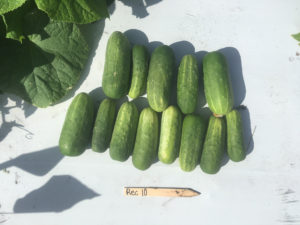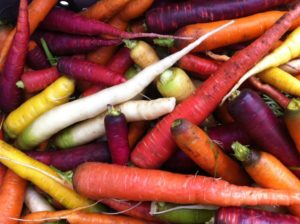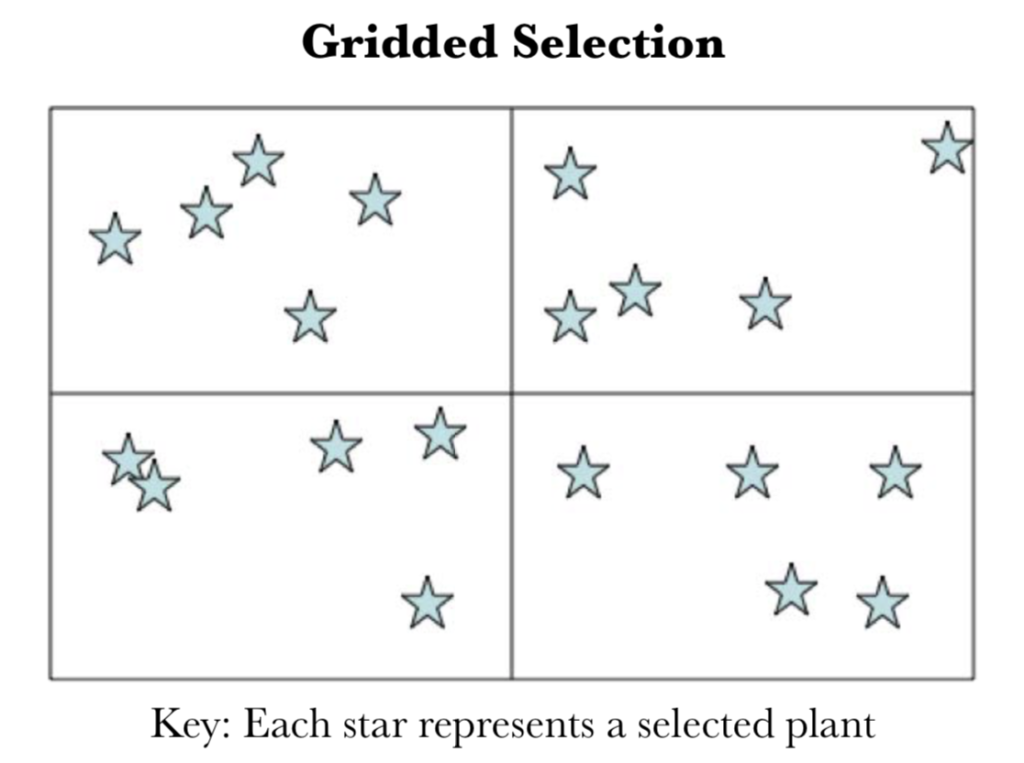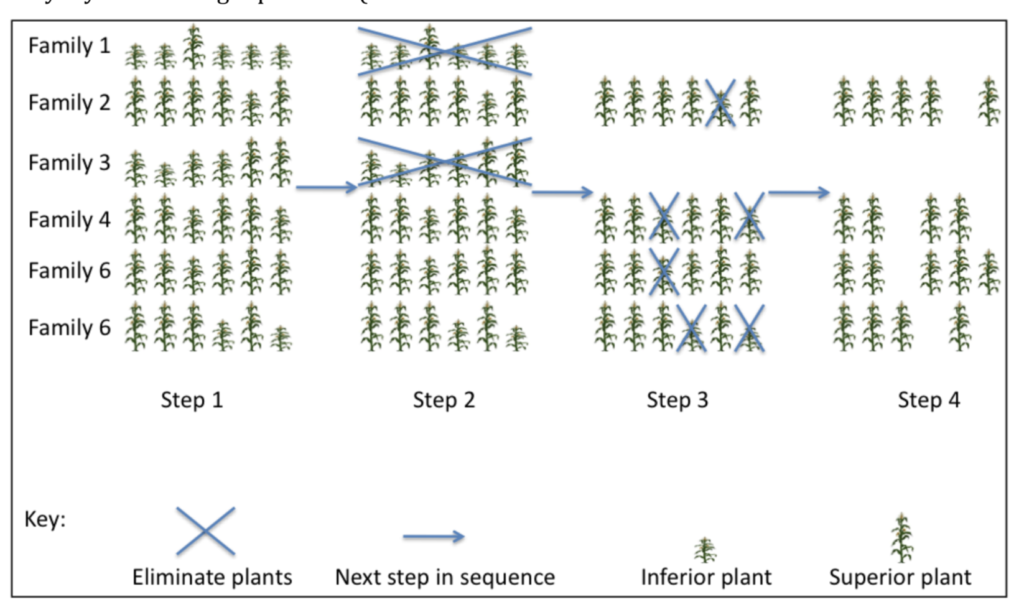On-Farm Variety Improvement Part II: Selection and Plant Breeding
This article is a follow up to “On-Farm Plant Breeding Pt. I: Getting Started with Diversity”, published in the Summer 2019 SFQ. Starting there will provide more context to understand the following information.
What is Selection?

An example of breeding of cucumbers with selection for fruit shape and quality. Mazourek Lab / CALS
Selection is the basis of planting breeding. When we talk about selection as plant breeders, we are referring to artificial selection — we walk into our field and advance a subset of plant individuals (by saving their seeds/tubers/cuttings and replanting them) that meet our objectives. Looking back through time, this is how crops where domesticated and improved — farmers picked out the plants that yielded the best, had large edible parts, weren’t bitter, hairy or poisonous, etc. This is in contrast to natural selection or “survival of the fittest,” which of course happens in natural ecosystems, but also happens in agricultural fields too. The ability for you to practice selection in your field depends on genetic diversity that is expressed in the plant’s phenotype. Ways to generate that diversity was the focus of Part I in this series.
In summary, you generated enough diversity to select upon by making a cross between two different varieties, planting a hybrid variety without any intellectual property restrictions, or identifying an open-pollinated variety or population that already displays variation for the traits you want to improve.
Helpful terms:
Allele: one of several versions of a gene; different versions have different functions or are non-functional. Usually caused by a genetic mutation at some point in the crop’s history.
Heritability: the proportion of observed (phenotypic) variation that is genetically determined, and therefore heritable by offspring.
Heterozygous: Two different alleles for a gene present in plant; one copy of each.
Homozygous: Two copies of the same allele are present.
Segregation: In a population, segregation refers to phenotypic variation resulting from the random assortment of alleles into pollen/egg cells, creating offspring with different phenotypes. For example, some offspring of a heterozygous purple-podded pea plant produce purple pods and some produce green pods.
What will you select for and how?
A very important step in the process is deciding what your goal is: what trait or traits will you select for? And if there is more than one, which will you prioritize? Another very important step is ensuring that the trait you want to improve is heritable. That means that the variation you observe is mostly due to genetic variation (which you can select for) rather than environmental variation (which you can’t). Heritability is a relative concept — it’s value changes across time and space. Examples of traits that generally have low heritability includes yield, seedling vigor and susceptibility to disease or stressors such as drought. Traits that tend to be more highly heritable include fruit or root color and shape, days to flowering or protein content of grain, or plant architecture. This doesn’t mean that you can’t make any improvement selecting for low heritability traits on your farm, just that it will take longer and environmental variation (and strategies to control for it) will play a more important role.
A related concept is simple vs. complex traits, which refers to how many genes are responsible for a trait or phenotype. For example, yield is generally based on many, many genes while flower color is often based on one gene. Disease resistance can be simple or complex, depending on the disease and resistance mechanism.

There is clear diversity within an open-source carrot population.
Courtesy of Open Source Seed Initiative
The next question to ask is how you will evaluate your trait. It is a trait you can easily walk through the field and identify? Or will you need to collect data – perhaps by cooking and evaluating flavor, measuring yield or doing a storage trial? Make sure you know how you will evaluate and determine superior plants. Another issue is when evaluation of a trait can only occur after a crop has been harvested — as with fruit quality evaluation in winter squash. That means you will have to harvest the whole crop (and possibly store it) before you can evaluate and identify superior plants. All of these factors will influence the logistics and time commitment of your project.
Selection Strategies
In general, the goal is to improve the traits that you care about, whatever they may be. You will do this by selecting the plants you like best and discarding (or selling, or eating) those you don’t.
In commercial cultivars, stability of a variety is very important — breeders strive for nearly complete uniformity from one plant to another, from one season to the next. Commercial growers often value this uniformity because they know exactly what they will be harvesting, when it will be mature and how much it will yield. To get a stable variety, you generally have to practice more intense selection repeatedly over many seasons to “weed” out any unwanted variation.
An important thing to remember is that selection inherently means reducing the genetic diversity of your starting population. This is fine, but it’s also worth considering that the more diverse a population or variety, the better the potential for future adaptation or improvement. In cross-pollinating crops, maintaining a minimum population size is also necessary to prevent inbreeding depression. Therefore, it may be worth preserving genetic variation that doesn’t have any negative impact on what you are trying to accomplish. For example, variation in baby kale leaf shape makes for a more interesting salad mix!
Formally trained plant breeders have many strategies for practicing selection, from old-school to genomic. Here are some fundamental strategies that are practical for on-farm plant breeding without an excessive amount of labor, time or infrastructure. Over several seasons, you may use multiple strategies at different stages of the process.
Mass Selection
The most common method of selection on the farm is mass selection, which simply means selecting the best plants in a plot or field and saving their seed separately to plant out in the next generation. This can be done either by “roguing” out poor performers (negative selection), or by picking the best performers (positive selection). This method works especially well with outcrossing species as it’s easy to maintain the larger population sizes you need, and the genetics of the pool will slowly improve as your selected plants continue to intermate over time. The disadvantage of this method is that you are selecting based on single plant characteristics, which are inevitably affected by environmental conditions. In mass selection of outcrossing crops, you also don’t know who your “pollen parent” is, so you are only selecting based on traits of the mother plant.
You will gain more from mass selection in cross-pollinated crops if you remove inferior plants from the field before pollination occurs. Otherwise those inferior plants will contribute pollen to future generations, decreasing gain from selection.
Mass selection is also used to maintain and improve varieties after they have been developed. For example, if you have an heirloom corn variety that you grow every year, you might save ears separately from the best plants each year to use as your seed for the next year, rather than taking your seed from the entire field’s harvest.
Family Selection
Family selection entails first selecting single plants (as in mass selection) but seeds from individual plants are then saved in separate bags and the following year, each bag is sown in a single row. Each row constitutes a “family.” For a self-pollinated crop, each plant in a row will be have the same mother and father plant (“S1 family” for self-pollination), while for cross-pollinated crops a row can either be a “full-sib” family if it was produced by a controlled cross between two different plants, or a “half-sib family” if mother plant was allowed to freely cross-pollinate, resulting in plants with the same mother but different father.
You can then advance or eliminate entire families together, as well as eliminating plants within families. Then aggregate the seed from all selected plants in selected families, plant it out in a row again next year and repeat the selection process. Because there is more relatedness and therefore genetic similarity within rows than between them, you can more easily sort through the environmental noise and identify plants that are genetically superior. While this method takes more work and space, it is useful in minimizing environmental effects that can greatly affect the phenotype of a plant.
Again, with cross-pollinated crops, this scheme works best if you physically remove inferior families or plants before pollination occurs. At the end of several generations of family selection, the winning families are ultimately combined to form a final population.

Sequential elimination within one generation of family selection.
Courtesy of Organic Seed Alliance
Family selection is also useful in self-pollinating crops for eliminating recessive traits in a segregating population that you don’t want. For example, I have a bean population with purple pods (a dominant trait), some homozygous and some heterozygous. If I grow out my bean offspring in family rows, I will see which rows are 100% purple-podded, which tells me that there are no recessive alleles hidden in that family. I then select those rows and get a true-breeding purple podded bean.
Thinking about Environmental Effects
As discussed earlier, some traits are more affected by environmental conditions than others. Selecting for a trait that is known to be highly heritable will likely go far in allowing you to successfully improve your crop without worrying too much about environmental effects.
For this reason, it’s a good idea to take into account field conditions when you are selecting — either use the gridded selection method to select the best plants from different sectors of the field, or use your knowledge of the field and plot layout to minimize environmental effects.
Another option if you are doing family selection is to plant multiple replications of your family plots in different places (divide up each bag of seed amongst three different smaller plots). That will help illuminate whether a family is really standout, or if it just happened to be planted in an advantageous location. The first article in this series discusses replication in trialing.

Selecting on a grid is a strategy for managing environmental variation across a field that affects phenotype
Courtesy of Organic Seed Alliance
What Next?
This series is intended to be a quick crash course in on-farm plant breeding, which has ideally gotten you hooked and left you wanting more. There are lots of wonderful and comprehensive resources available that can guide you more deeply into the intricacies of genetics, plant breeding methods, and more. Below is a list of where you might start looking.
Another important topic not covered here is seed saving. As methods for this vary from crop to crop, we recommend taking advantage of the many resources available on this subject.
Sources for more Info:
Breeding Organic Vegetables: A Step-by-Step Guide for Growers. Rowen White and Bryan Connoly. Published by NOFA-NY.
Breed Your Own Vegetable Varieties. Carole Deppe. Chelsea Green Publishing: 2000.
The Organic Seed Grower: A Farmer’s Guide to Vegetable Seed Production. John Navazio. Chelsea Green Publishing: 2012.
Organic Seed Alliance Resources:
Introduction to On-Farm Plant Breeding. 2017.
The Grower’s Guide to Conducting On-Farm Variety Trials. 2018.
https://seedalliance.org/publications/growers-guide-conducting-farm-variety-trials/
Extension.org:
Seeds and Seed Production in Organic Farming Resource Guide

